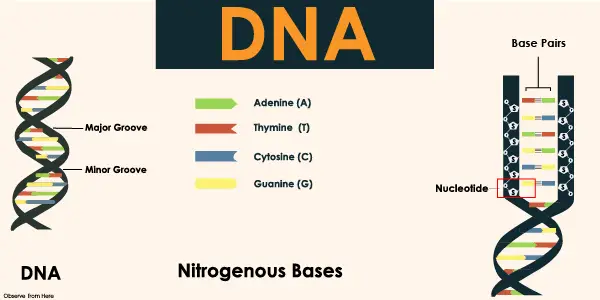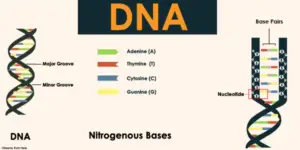
What is DNA
What is DNA? It is a molecule that bears the responsibility for storing and translating the genetic information in living organisms. The DNA is found in the nucleus of cells, and its shape can be described as a double spiral staircase, & it consists of two bands and it forms chromosomes by supercoiling itself.
The word DNA is an abbreviation of DeoxyriboNucleic Acid which carries the genetic information present in the cell from one generation to another, and therefore it is possible to determine a person’s ancestors, by analyzing it, from By taking a sample of blood, hair, nails, or saliva and oral cells.
There is no rocket science to understand what are chromosomes. They are actually made when long DNA strands supercoil over each other. It is actually freely moving inside the cell’s nucleus but when it get supercoiled over histone proteins it gets a shape called chromosomes and chromosomes bear the congenital and physical characteristics of living organisms.
Components of DNA:
Components of DNA: It can be described as a long thin molecule consisting of things called (nucleotides), and these nucleotides link together forming a backbone. These nucleotides are consisting of nitrogenous bases, sugar, and phosphate groups. Nitrogenous Base can be Guanine, Cytosine, Thymine, and Adenine.

Function of DNA:
Function of DNA: the cells obtain the instructions required to perform their function from DNA. The cell can be considered a computer while Deoxy Ribonucleic Acid can be considered a computer program. It is the program that gives instructions to the computer and tells the computer how to behaves and how to functions.
The ATGC sequence in Deoxy Ribonucleic Acid strand OR nucleotide sequence work as code and its the thing which makes a person unique from others. Each 3 letter are called codons. The codon series may look something like this: ATC, GTC, AAT, GAC.
DNA Location and structure:
DNA Location: In eukaryotic or multicellular organisms DNA is located inside the nucleus of the cell WHILE in case of prokaryotic or unicellular organisms it is freely moving inside the cytosol of the cell because prokaryotes do not have a nucleus in their cells.
Structure:
The structure of DNA is comprised of Nitrogenous bases attached with pentose sugar and these pentose sugars attached with a phosphate group. The complex of these three things makes up a single nucleotide. These nucleotides are attached in series making up a strand that is double helical with major & minor groove in it.
What are genes?
A specific nucleotide sequence of DNA strand that codes for protein is called genes. These coding sequences in it make functional proteins. These functional proteins are made in such a way that DNA first transcribes RNA and this RNA will ultimately get translated into proteins that are functional.
What is the mutation?
Any change or deviation from the original size, shape or function is called mutation. When there is a mutation in nucleotide sequence, amino acid sequence or in the body of chromosome severe or complex medical complications may occur to the organism.
Mutations in such things can be harmful, beneficial, or non-effective. The one that does not show any bad or harmful impact on the organism is non-effective mutation while the one that shows dangerous impacts on the organism are harmful mutations. In rare cases, mutations can be beneficial to the organism in many ways.
Also Read: Polymerase Chain Reaction
Conclusion:
we have gone through what is DNA, it is the most crucial particle in the life of every organism and there is no life possible without this particle. It contains massive information about the organism in the form of hereditary material. All the genes that an organism posses are the specific DNA sequences that code for functional amino acids. Ultimately the whole genes present in an organism is known as the genome of the organism.
You may also enjoy reading: